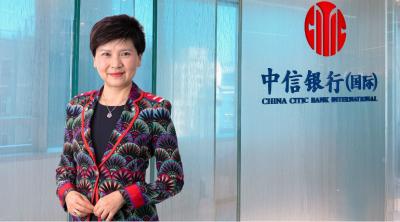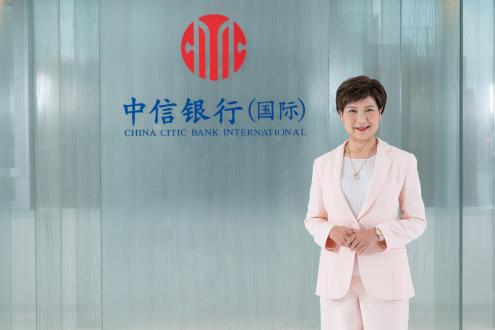China CITIC Bank International Expert Helen Kan on how Operational and Compliance Improvements can Boost Client Engagement

Helen Kan of China CITIC Bank International
Jul 14, 2022
Helen Kan is Executive Director, Deputy Chief Executive Officer and Head of Personal & Business Banking Group at China CITIC Bank International and a long-term friend of Hubbis that we have turned to on many occasions for her expertise in wealth management. She joined our select panel of experts for our Digital Dialogue discussion Hubbis on May 26, which centred on how private banks are overcoming key operational, productivity and compliance risks and challenges and how some of these can be converted to business and competitive gains. We have distilled some of her very detailed and valuable insights into this short report.
Helen Kan is a financial service industry leader with global, regional and Hong Kong/China expertise garnered over an illustrious career spanning more than 30 years. Currently, she sits on the Board of China CITIC Bank International Limited as Executive Director and Deputy CEO, managing Business Banking, Private Banking and the Retail Banking businesses. She is also the Director of various subsidiaries of the Bank and a Director of Nova Credit Limited.
She is very engaged in the local community. Helen is currently a council member of the Hong Kong University of Science and Technology and a member of the Hong Kong Academy of Finance. She is also the President of the Hong Kong Women Professionals and Entrepreneurs Association (HKWPEA), a member of the Hong Kong Professionals And Senior Executives Association, and The Hong Kong Chi Tung Association.
A bird’s eye view
Armed with all this experience and the wide range of professional and community involvement, Helen offered our delegates an immensely wide view of the key issues of the discussion. She set the scene by first explaining that China CITIC Bank International is a subsidiary of China CITIC Bank, the main operating market is in Hong Kong, and they have branches in Singapore, Macau and the US. They serve customers all the way from retail to HNW clients and beyond.
China CITIC Bank, she reported, has 120 million individual customers, including 60,000 private banking customers in China. “And this is important,” she said, “because, as a recent KPMG report indicated, some 54% of Hong Kong's wealth management AUM is going to come from Mainland China by 2025,” she told delegates. “So, this is the massive opportunity in terms of the wealth allocation of Mainland customers, with Hong Kong being a gateway, both to China and also to the outside world.”
Rising intra-regional activity
And she said that with the arrival of Wealth Management Connect (WMC), there would be more and more money flowing in and out within the region, especially south and north to and from Hong Kong.
“Interestingly,” she explained, “in the early stage of WMC, the northbound money flows are actually higher, as Hong Kong investors are increasingly interested in Chinese wealth management products. The southbound flow will certainly increase in the future. Thus, every private bank, every full-scale commercial bank, the virtual banks, the foreign banks, the China-based banks, literally everyone is vying for a larger share of the wealth management market in Hong Kong.”
Ahead of the game
Shifting her attention to the detail of operations and practices, Helen told delegates that while the pandemic had fast-tracked irreversible changes in customer expectations, the bank’s internal strategy for the past roughly five years had already been towards mobile and digital-first.
“I can say that our mobile app has to a big extent ‘saved’ us through these difficult times, allowing us to onboard, and also to retain and engage with customers, both in Hong Kong and Mainland China,” she told delegates. “Moreover, to overcome disruptions, we have taken up many timely changes and improvements in our compliance procedures to accommodate these changes in the operating environment. Of course, there has been an impact due to border closures and so forth, especially in heavily regulated areas such as insurance transactions and some investment fulfilment, but we came through well, and with the eventual re-opening up, we are actively preparing for the next wave of growth.”
The drive to digitise
Helen offered more perspective on the digitisation journey, noting that the bank’s view, even pre-COVID, was that digital is bread and butter for all segments of customers, especially amongst the younger generations.
“We have worked hard to boost digital adoption by clients and the RMs, focusing on the success formula of making it all as intuitive as possible,” Helen reported. “We can now seamlessly onboard a customer totally remotely; they can transact across the markets and asset classes; they can conduct portfolio management. In short, our platform is suitable for all, from the robo-advisory self-directed customer to those segments that need a hybrid advisory model to those who seek support from the RMs.”
The hybrid wealth model
Elaborating on the role of the RM, she explained that the RM remains central to the bank’s offering and will remain so in the foreseeable future.
“Customers can contact our RMs for all types of support, from onboarding to education, to advice and of course transacting and resolving issues,” she said. “As I said, a lot of our customers are based in China, and their understanding of the banking habits in Hong Kong and the rules and the products are actually quite different. Accordingly, that cultural bridge calls for the RM to be effective in building and securing engaging relationship. Additionally, we offer specialists, including for insurance, investments and even for alternative assets, partnering with external experts where we need to deliver the best solutions.”
End-to-end solutions and enhancements
Helen also responded to another panellist’s observations on driving efficiencies. “We have been building efficiency and elevating the overall proposition from back to middle to front at the bank,” she reported.
“At the front end, this centres on the usability and the convenience of the digital platform. In the middle, processing must be fast and accurate, with seamless approvals, so we have put in a lot of effort to compress and improve these processes. At the back-end, we have improved compliance and credit function enabling support.”
Driving customer loyalty and satisfaction
In summary, she said the bank adopted agility as a cultural transformation and achieved visible progress, with teams working together and really creating an end-to-end process serving the customer needs. “We measure it all in both time and quality so that all the advances are seen at the front-line where the clients interact with us,” she stated. And that, of course, drives better customer share of wallet and client satisfaction and then loyalty.
Advancing the science of compliance
Helen then zoomed in on some details relating to onboarding, remarking that the bank had worked closely with the regulator a few years back on the issue of proof of identity and address. “We have managed through collaboration and engagement to strip off some legacy regulatory requirements, liaising with the regulator to overcome issues around the remote onboarding of clients,” she reported.
She added that suitability assessment protocols had also been evolving, with more and more control points added to the process. “Faced with this, we created a task force to try to reduce the time and the burden on clients to achieve the right suitability outcomes,” she reported. “The compliance department had to work closely with the business teams to fulfil this principle-based supervision on one hand, but on the other hand ensure more intuitive, simple, and customer-centric process. And that is what we have achieved.”
Leveraging technology to optimise outcomes
Helen also explained that a big-picture mission was to really understand and then apply how they can use technology to make the cost of compliance cheaper, and actually more accurate or effective. “We are striving for a more systematic and quantitative basis for helping us to make risk-based assessment, invest in technology for broad compliance advances, to achieve long term cost efficiencies,” she said.
And this, she indicated, means the simplification of processes and improvement of outcomes that will, in turn, both reduce costs and also boost client satisfaction and result in better and more business.

Executive Director, Deputy Chief Executive Officer and Head of Personal & Business Banking Group at China CITIC Bank International
More from Helen Kan, China CITIC Bank International
Latest Articles






